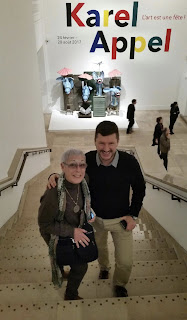And let the fiesta begin…Karel Appel was a member of the COBRA group. When I went to Eve & Adele, there was a photo at the end of the chapter showing us that the new exhibition was about to start. Jerome called and said let’s go on Sunday. Exhibitions at the weekend are not my cup of tea due to the crowds. We arrived and hardly a soul around. Into the exhibition and virtually no-one. We would see Appel in the best of conditions.

No way I could tell you
where and when I « fell in love » with Karel Appel’s (1921-2006) work.
He was Dutch and died at 85, in Switzerland. I’m pretty sure that I came
across him when I discovered the COBRA group -I already knew Asger
Jorn’s work but it really began with another Dutch Painter - Constant.
Appel was looking for a new opening, another expression. The Dutch
artists went to Paris in 1948 for and international conference on
avant-garde art organized by the Surrealists. To show their disagreement
with the French the 7 artists left the meeting and met up in a
wonderful café, Le Notre Damé café and on the 8th of November they
formed CoBrA in reference to their countries of origin (Copenhagen,
Brussels, and Amsterdam). Appel didn’t go along with the political
leanings of certain other members of the group. Nevertheless, his work
incarnates a certain primitif quality that was dear to the group’s
creations: scribbling, bright colors, sculptures … as if the group were
reviving their childhood memories. Or perhaps even reverting to
childhood.
 |
| Green Figure 1947 |
 |
| Petit Hip Hip Hourra - 1947 |
 |
| Night Bird - 1949 |
 |
| Children begging (done on wood) 1948 |
 |
| Animals under a village - 1951 |
 |
| Two Owls - 1948 |
 |
| La Promenade - 1950 |
 |
| A Standing Figure - 1947 |
 |
| Animal world - 1948 |
 |
| No Title - 1949 |
 |
| Tree - 1949 |
Appel moved to Paris in 1950 and stayed there after CoBrA was dissolved in 1951. Although other members of the group created new groups, Appel continued along a rather solitary path and became « Parisian » . He caught the attention of a major French art critic. Tapié was fascinated by his work and when we looked at a video showing how Appel painted, using the tube itself and applying paint generously. The vigor and very aggressive way he threw the paint around was somewhat daunting. Tapié also introduced him to a New York galley and from 1957 onwards he divided his time between Paris and New York.
 |
| Black Virgin - 1952 |
 |
| Desert Dancers - 1954 |
 |
| Tragic Carnaval - 1954 |
 |
| Cesar's Portrait - 1956 |
 |
| Tragic Head - 1956 |
 |
| Girl - 1957 |
 |
| Tragic Nude - 1956 |
 |
| Portrait of Micel Tapié - 1956 |
 |
| Wounded Nude - 1959 |
Following his first stay in New York, his paintings became increasingly bigger. Then too, he was moving away from animals and childlike themes of the CoBrA period. He began to explore other avenues : nudes, landscapes which seem to have an almost abstract character. When back in France where he spent his summers in Nice in 1960 and 1961 he created one of the most important series of sculptures using olive tree stumps. I just hope he wasn’t cutting down the trees so he could use them! He was in every way an experimental artist, looking for new ways and material to go further in his artistic development.
 |
| Machteld (Nude series) 1962 | |
 |
| Man and the Owl - 1960 | |
 |
| Archaic Life - 1961 |
 |
| Woman with Flowers No. 4 - 1963 |
 |
| Potato head - 1974 |
I love the circus he created in 1978. There are 17 sculptures. Funny like a circus should be. Jerome asked me that if I had the place top take one home, which would it be? I chose this - the smallest! See below...
THE CIRCUS - 1978
 |
| That's the one I chose in the middle |
In the latter years,
1980, 1990 and 2000 he is back in New York where he created a set of
monumental painted panels. These had figures of giants and dramatic
scenes in general.
At the end of his life he adopted a new style once
more which announced his final work. It’s pretty stark but it was only
at the end of the exhibition that I discovered his Singing Donkeys in
papier mâché which announce another style and yet probably even more
rigid than in the early years. Perhaps not a joyful as at the beginning
but how could you not like it?
 |
| Before the Catastrophe - 1985 |
 |
| Nude Figure - 1989 |
 |
| The Beheaded - 1982 |
 |
| Full picture of The Beheaded - 1982 |
 |
| Waiting Woman - 2000 |
 |
| Laurent and Jerome behind |
 |
| The Fall of the horse in a silent space - 2000 |
 |
| Yellow nude - 2000 |
 |
| Another angle of The Fall of the Horse |
 |
| This is one of the paintings we saw on the Video |
 |
| Just looking... | | | | | |
And just imagine if you saw this today in Paris....
My brother sent me over this little video from YouTube. It's really great fun...have a look and see for yourself his torturous way of painting
Karel Appel
















































Commentaires